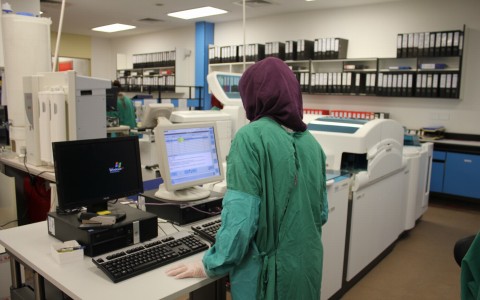Blood Chemistry 101 from a Functional Medicine Perspective
- Introduction to Blood Test Analysis
- Understanding Complete Blood Count (CBC)
- Insight into Complete Metabolic Panel (CMP)
- Studying Vitamin D
- Inflammation Markers - CRP
- Decoding Thyroid Markers
- Iron Markers
- Lipid Panel Assessment
- Micronutrient Markers: Folate, Vitamin B12
- Micronutrient Markers: Zinc, Copper, Magnesium
- Other Key Blood Chemistry Markers
- Implementing Lifestyle Recommendations for Improved Markers
- Pulling It All Together – Your Personal Health Assessment
Introduction to Blood Test Analysis
Decoding Medical Jargon in Blood Tests

Laboratory analysis performed on a blood sample.
Understanding the language of blood tests can be a daunting task, especially when it's filled with medical jargon. However, with a little guidance, you can learn to decode these terms and understand what they mean for your health.
Common Terms in Blood Tests
Here are some common terms you might encounter in your blood test results:
-
Hematocrit (HCT): This measures the proportion of your blood that is made up of red blood cells. It's expressed as a percentage.
-
Hemoglobin (HGB): Hemoglobin is a protein in your red blood cells that carries oxygen. This test measures the amount of hemoglobin in your blood.
-
Platelets (PLT): Platelets are cells that help your blood clot. This test measures the number of platelets in your blood.
-
White Blood Cells (WBC): These cells help your body fight infections. This test measures the number of white blood cells in your blood.
Understanding 'Normal' and 'Optimal' Ranges
When you receive your blood test results, they will usually include a 'reference range'. This is a range of values that is considered 'normal'. However, it's important to understand that 'normal' doesn't necessarily mean 'optimal'.
For example, the normal range for hemoglobin might be 13.5 to 17.5 grams per deciliter for men and 12.0 to 15.5 grams per deciliter for women. But if your hemoglobin level is at the lower end of this range, you might still experience symptoms of anemia, such as fatigue and weakness.
In functional medicine, the focus is often on achieving 'optimal' levels rather than just 'normal' levels. This means aiming for levels that are associated with the best health outcomes, rather than just avoiding disease.
The Significance of Units of Measurement
Finally, it's important to understand the units of measurement used in blood tests. These can vary depending on the specific test and the laboratory that analyzes the sample.
For example, hemoglobin is usually measured in grams per deciliter (g/dL), while white blood cells are usually measured in cells per microliter (cells/µL). Understanding these units can help you make sense of your results and compare them to the reference ranges.
In conclusion, understanding the language of blood tests is an important step towards taking control of your health. By learning to decode medical jargon, you can gain a better understanding of your test results and make more informed decisions about your health care.